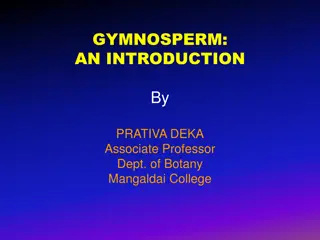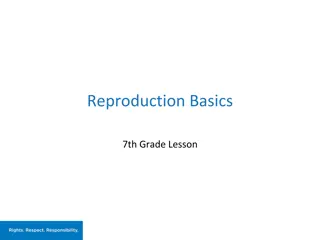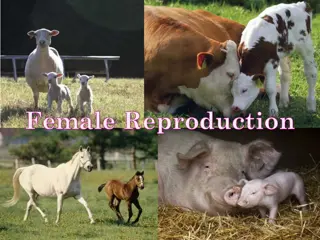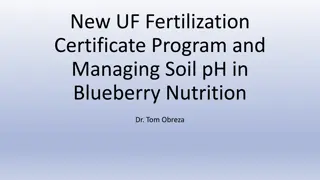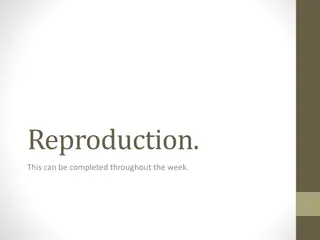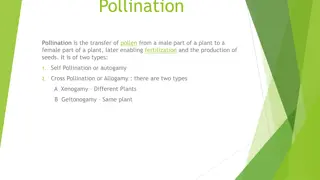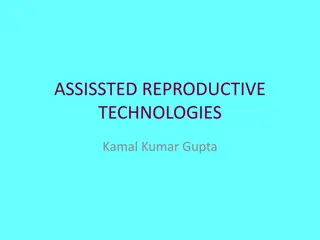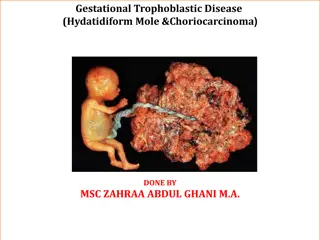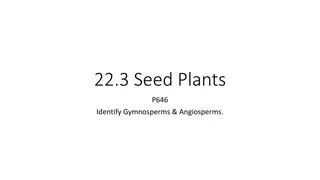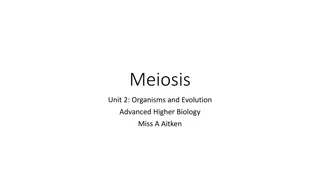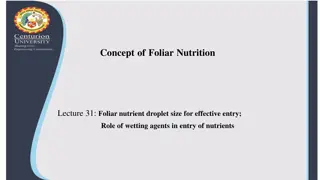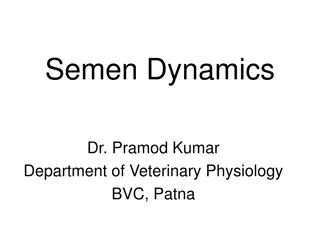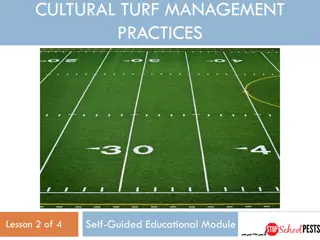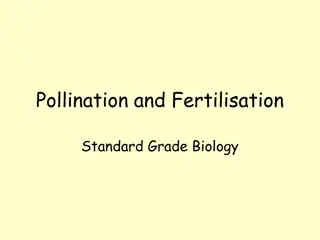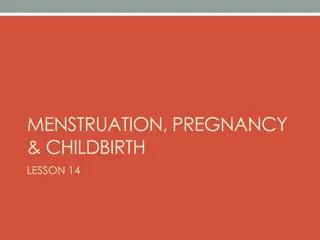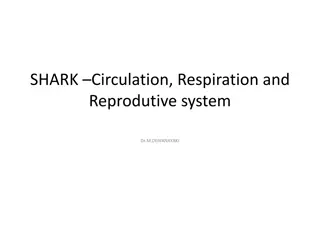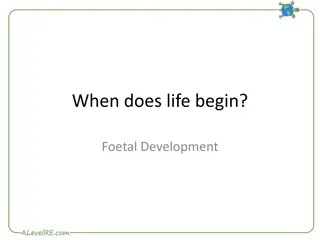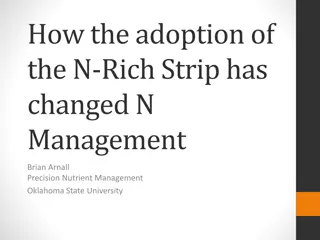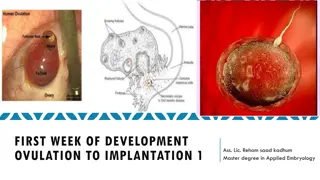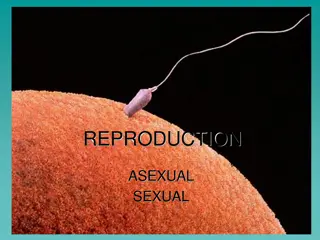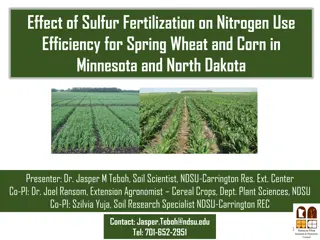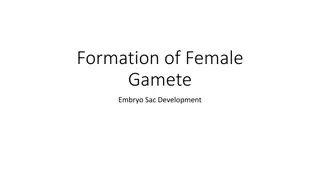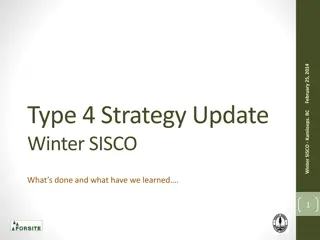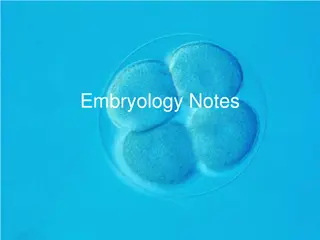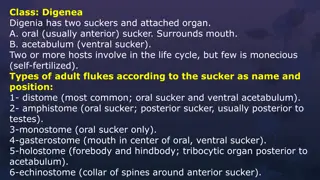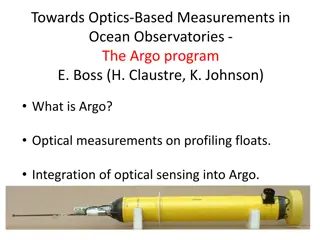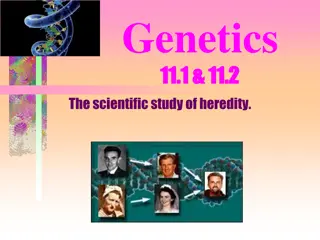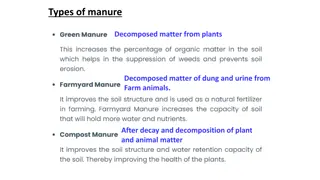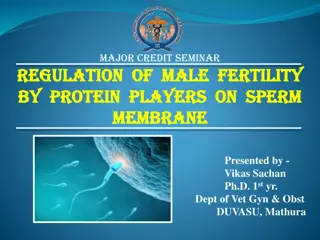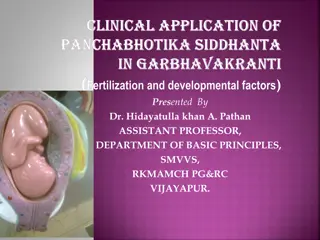Introduction to Gymnosperms: Key Characteristics and Features
Gymnosperms are seed-producing plants with exposed ovules, lacking fruits. They have true roots, stems, and leaves, with majority being tall, woody, perennial plants. Male and female flowers are borne on separate structures, and pollination occurs via wind. Gymnosperms exhibit unique features such a
6 views • 6 slides
The Benefits of Organic Goat Mowing for Your Lawn
Discover the advantages of using goats for lawn mowing, including cost savings, environmental benefits, weed control, and natural fertilization. Goats offer a sustainable and efficient way to maintain your property while reducing the need for pesticides and herbicides. Embrace a greener approach to
2 views • 14 slides
Understanding Fertility and the Menstrual Cycle in 7th Grade
Female reproductive health lesson for 7th graders covering topics such as the menstrual cycle, ovulation, fertilization, pregnancy, and menstruation. Explains the role of the uterus, ovaries, and hormones in the reproductive process. Suitable for young learners to understand basic concepts of fertil
3 views • 9 slides
Understanding Female Reproduction System
The female reproduction system plays a crucial role in producing fertile eggs, hormones, and facilitating fertilization, pregnancy, and birth. Key terms like estrous and estrus, ovulation, and folliculogenesis are essential to grasp. The female reproductive tract consists of tubular organs like the
0 views • 27 slides
New UF Fertilization Certificate Program and Blueberry Soil pH Management
Explore the new UF Fertilization Certificate Program offering courses in fertilizer science and technology, focusing on soil pH management for blueberry nutrition. The program includes required and elective courses, field visits, and opportunities for scholarships/internships. Targeted towards gradu
0 views • 20 slides
Understanding Reproduction: Pollen, Eggs, and Life Cycles in Plants
Reproduction in plants involves the transfer of pollen to eggs, leading to fertilization and the formation of new life. Male animals produce sperm, while females produce eggs, which fertilize when they meet. Different animals exhibit external or internal fertilization, with varying numbers of offspr
1 views • 13 slides
Understanding Plant Embryogenesis: A Comprehensive Overview
Plant embryogenesis is a crucial process in the development of plant embryos from fertilized ovules, involving cell division, differentiation, and morphogenesis. This process leads to the formation of seeds, which play a vital role in the plant life cycle. The stages of embryo formation, structure,
0 views • 25 slides
Understanding Pollination: Types and Factors
Pollination is the crucial process of transferring pollen for fertilization and seed production in plants. It can be self-pollination or cross-pollination, with different types of dehiscence affecting how pollen is released. Self-pollination occurs in hermaphroditic and monoecious plants, with facto
0 views • 22 slides
Assisted Reproductive Technologies: Gamete Intra-fallopian Transfer (GIFT)
Assisted Reproductive Technologies (ART), such as Gamete Intra-fallopian Transfer (GIFT), offer a method for couples struggling with infertility. GIFT involves placing fertilized eggs in the fallopian tubes, unlike In Vitro Fertilization (IVF). The procedure requires healthy fallopian tubes and offe
1 views • 25 slides
Understanding Prezygotic Reproductive Isolating Mechanisms
Prezygotic reproductive isolating mechanisms prevent mating or fertilization between different species before it can occur. Examples include habitat isolation, behavioral isolation, and temporal isolation. These mechanisms play a significant role in maintaining species integrity and preventing the f
0 views • 4 slides
Understanding Gestational Trophoblastic Disease: Hydatidiform Mole & Choriocarcinoma
Gestational trophoblastic disease encompasses hydatidiform mole, invasive mole, and choriocarcinoma. This condition involves abnormal fertilization of the oocyte, resulting in various presentations including abnormal growth of the uterus, severe nausea, vaginal bleeding, and symptoms resembling hype
1 views • 9 slides
Understanding Seed Plants: Gymnosperms and Angiosperms
Learn about the adaptations that allow seed plants to reproduce without open water, the importance of seeds, and the differences between gymnosperms and angiosperms. Explore how gymnosperms carry out fertilization without water in their life cycle. Images included.
0 views • 5 slides
Understanding Meiosis: Key Concepts in Biological Evolution
Meiosis is a crucial process in organisms, involving the formation of haploid gametes with unique allele combinations. This process ensures genetic diversity through crossing over and independent assortment, leading to variations essential for evolution. The significance of homologous chromosomes, d
1 views • 22 slides
Understanding Foliar Nutrition: Droplet Size and Wetting Agents
Foliar nutrition focuses on the effective entry of nutrients into plants through foliar applications. Key factors include droplet size for optimal absorption, the role of wetting agents in nutrient entry, and the importance of fertilizer materials with high solubility and purity. Smaller droplets en
0 views • 8 slides
Understanding Semen Dynamics and Capacitation in Mammalian Spermatozoa
Semen dynamics play a crucial role in mammalian reproduction, with capacitation being a key process for sperm fertilization capability. Capacitation involves physiological changes in sperm, leading to the acrosome reaction, crucial for oocyte penetration. As sperm transit through the epididymis, the
5 views • 13 slides
In Vitro Fertilization_ Understanding the Process and Its Benefits
In vitro fertilization elivaclinic.co.uk has revolutionized the field of reproductive medicine, offering hope to many who struggle with infertility. By understanding the IVF process and its numerous benefits, individuals and couples can make informed
0 views • 5 slides
Best Practices for Turf Management
Learn about cultural turf management practices including mowing, fertilization, irrigation, soil analysis, aeration, and overseeding. Discover important tips such as keeping mower blades sharp, adhering to the one-third rule for mowing height, and the impact of mowing frequency on turf density and w
0 views • 38 slides
Empowering Women with Disabilities Through Vegetable Gardening Project
Re tla Kgona Disability Centre in South Africa aims to empower women with disabilities by creating jobs, preventing poverty, and encouraging community participation. The project involves activities like soil preparation, fertilization, and marketing, with partnerships for support. With a focus on em
0 views • 12 slides
Understanding the Menstrual Cycle: Phases and Hormonal Regulation
Menstruation is a natural process where the uterine lining sheds accompanied by bleeding in monthly cycles. The menstrual cycle consists of three phases - Follicular, Ovulatory, and Luteal - regulated by hormones like estrogen and progesterone. This cycle starts with menstruation, followed by the re
0 views • 11 slides
Understanding Pollination, Fertilization, and Flower Features
Explore the intricate processes of pollination and fertilization in plants, including self-pollination and cross-pollination. Discover how wind-pollinated and insect-pollinated flowers differ in features and mechanisms. Dive into the fascinating world of plant reproduction through informative visual
0 views • 8 slides
Understanding Menstruation, Pregnancy, and Childbirth Lesson 14
This lesson covers various aspects related to menstruation, conception, and the female sexual cycle. It explains what menstruation is, common facts about periods, the female sexual cycle, and details about the menstrual cycle phases. Information on hormones controlling menstruation, ovulation, ferti
0 views • 34 slides
Shark Circulatory, Respiratory & Reproductive Systems Overview
A detailed look into the circulation, respiration, and reproductive systems of sharks. The circulatory system of sharks includes a unique heat retention mechanism due to red muscle activity, with blood flowing from the heart to gills and back. The respiratory system involves heat generation in red m
0 views • 10 slides
Understanding when Life Begins: Key Points in the Abortion Debate
Identifying when life begins is essential in the abortion debate. The concept of life is complex, involving milestones like fertilization, heartbeat, sentience, viability, and birth. Various ethical and moral considerations influence our perspective on the beginning of life, highlighting the nuanced
0 views • 11 slides
Evolution of N-Rich Strip Adoption in N Management
The adoption of N-Rich Strip has transformed nitrogen management practices over the years. Starting from small applications in 2003 to widespread utilization across acres in Oklahoma and Kansas, the confidence in this approach has grown significantly. Farmers are advised to monitor N-rich strips and
0 views • 17 slides
Alternative Reproductive Techniques in Fertility Treatments
Alternative reproductive techniques such as Gamete Intra-Fallopian Transfer (GIFT) offer options beyond traditional in vitro fertilization for women facing certain infertility challenges. GIFT involves transferring washed sperm and harvested ova to the fallopian tube via laparoscopy, allowing fertil
0 views • 13 slides
Asexual Reproduction in Plants: Methods and Examples
Asexual reproduction in plants, also known as vegetative propagation, involves various methods such as tubers, bulbs, and runners. It allows plants to reproduce without the involvement of sex cells and fertilization, resulting in genetically identical offspring. Artificial propagation techniques lik
0 views • 11 slides
Overview of the First Week of Development from Ovulation to Implantation
The first week of development after ovulation involves key processes like fertilization, cleavage, and blastocyst formation. It begins with the maturation of the primary oocyte in the follicle, leading to ovulation and potential fertilization. During this period, hormonal changes in the ovarian cycl
0 views • 21 slides
A Comparison of Human and Frog Anatomy and Physiology
Humans and frogs share many similarities in their organ systems such as lungs, digestive, circulatory, skeletal, and muscular systems. However, there are also significant differences in body configuration, respiratory system, skeletal structure, and reproductive system. Frogs have unique features li
0 views • 7 slides
Understanding Reproductive Modes: Asexual vs. Sexual
Reproduction can occur through asexual or sexual means, each with its distinct processes and outcomes. Asexual reproduction involves only one parent and produces genetically identical offspring, while sexual reproduction involves the fusion of specialized sex cells from two parents to create genetic
1 views • 46 slides
Effect of Sulfur Fertilization on Nitrogen Use Efficiency for Spring Wheat and Corn
This research project, conducted by Dr. Jasper M. Teboh and his team at NDSU, investigates the impact of sulfur fertilization on nitrogen use efficiency for spring wheat and corn in Minnesota and North Dakota. The study aims to determine if wheat or corn respond to sulfur application, how sulfur aff
0 views • 25 slides
Development of Female Gamete and Embryo Sac in Plant Reproduction
In plant reproduction, the formation of female gametes involves meiosis in cells of the carpel sac, leading to the development of the embryo sac or megaspore. Meiosis results in four haploid cells, of which three degenerate, and one survives. This surviving cell undergoes multiple rounds of mitosis,
0 views • 7 slides
Strategy Update on Winter SISCO Project in Kamloops, BC
The strategy update for the Winter SISCO project in Kamloops, BC highlights the progress made in various areas and key learnings. Prioritizing rehabilitation treatments over fertilization due to potential merchantable volume benefits, the update delves into technical analysis, planning processes, an
0 views • 49 slides
Embryology Notes: Development from Fertilization to Gastrulation
Embryology is the study of the development of multicellular animals starting from fertilization when the sperm fertilizes the egg and forms the zygote. This initiates a series of events such as cleavage, morula formation, blastula development, and gastrulation, where three embryonic tissue layers ar
0 views • 24 slides
Anatomy and Biology of Class Digenea Digenia Adult Flukes
Digenea Digenia, a class of parasitic flatworms, have distinctive anatomy and biology. Adult flukes possess two suckers, oral and acetabulum, and exhibit different types based on sucker positioning. Their tegument consists of two zones, with various chemicals for survival. The alimentary tract is in
0 views • 14 slides
European Railway Clusters Initiative (ERCI) Summary and Contact Information
European Railway Clusters Initiative (ERCI) focuses on increasing competitiveness in the railway industry through collaborative RDI projects, assisting SMEs in R&D strategy development, ensuring rapid market uptake, and fostering cross-fertilization with other sectors and technologies. The initiativ
0 views • 6 slides
Advancements in Optical Measurements for Ocean Observatories: The Argo Program
The Argo program integrates optical sensing into ocean observatories using profiling floats to gather data from the deep sea. With nearly 1,000,000 profiles to date, the Argo Observing System offers a global, real-time monitoring solution. Utilizing optics on profiling floats has enabled observation
0 views • 12 slides
Understanding Genetics: The Study of Heredity and Mendel's Discoveries
Explore the fascinating world of genetics through the scientific study of heredity and the groundbreaking work of Gregor Mendel, the Father of Genetics. Learn about hereditary traits, the role of fertilization, Mendel's experiments with pea plants, and the concepts of genes and alleles that shape bi
0 views • 23 slides
A Comprehensive Guide to Fertilizers and Manure for Agriculture
Explore the various types of manure, nutrients in fertilizers, organic and inorganic fertilizers, biofertilizers, pond fertilization techniques, and factors influencing proper pond fertilization. Learn about different types of fertilizers used for pond fertilization, including solid fertilizers. Enh
0 views • 17 slides
Protein Players in Male Fertility Regulation
Cooperative interactions between proteins on sperm membranes play a crucial role in male fertility regulation, affecting sperm migration, binding to the oviduct, and successful fertilization. Understanding these protein factors is essential for comprehending the complex process of mammalian fertiliz
0 views • 62 slides
Clinical Application of Panchabhautika Siddhanta in Garbhavakranti: Fertilization and Developmental Factors
Ayurveda explores the significance of the Panchamahabhoota (five elements) in the process of Garbhavakranti (fertilization and development). The concept of Bhoota, Srustiutpattikrama, and clinical applications of Panchamahabhoota are discussed, aligning ancient wisdom with modern evolutionary theori
0 views • 25 slides
